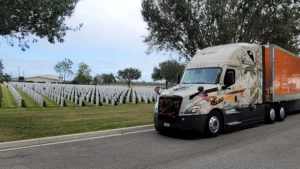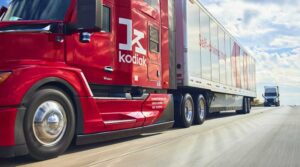Parts shortages and dwindling inventories are holding back what should be a robust new Class 8 truck market, according to Kenny Vieth, president and senior analyst at ACT Research.
“The industry is still having just the hardest time building units,” he told The Trucker. “Inventories are super low. And so sales, at least on a seasonally adjusted basis, have really softened up.”
According to ACT, 20,369 new Class 8 trucks were sold in June on the U.S. market. That’s an 8.6% improvement over May sales of 18,761 and a whopping 50.1% better than June 2020 sales of just 13,567. Last year, the market was just beginning to recover from its lowest point of 9,510 trucks moved in May.
A better comparison might be the 25,607 Class 8 trucks sold in June 2019, when the backlog of orders was shrinking as assembly lines reached for maximum output. June 2021 sales trailed that figure by 5,238 (20.4%).
June is typically a strong sales month for trucks, in part because it’s the final month of the second quarter. When profits are strong, carriers tend to invest in new equipment at the end of each quarter. Investments reduce the amount of profit that must be reported and the taxes that are paid on that profit.
Vieth said inventories haven’t been this low in years.
“I have to go back to June of 2017 to find a lower inventory number,” he said.
Record prices for steel and other materials haven’t helped. Global shortages of plastics, parts and, especially, semiconductors are keeping production levels down, too.
“All these supply chain constraints are just making it very difficult for the industry to shift into to another gear for production,” Vieth explained.
“Semiconductors is the big one, because semiconductors go into so many different products used on a truck, like door actuators or instrument panel clusters,” he stressed. “There are silicon chips all over the place.”
A single vehicle can use more than 100 semiconductor “chips” in parts as small as a turn-signal indicator up to the electronic control modules (ECMs) in engines and transmissions. Modern electronics-based safety equipment, such as collision avoidance, vehicle stabilization and lane departure, also require semiconductors.
In a typical recession, some industries are able to amass large inventories of products while sales are down. When the recovery begins, products are available to get the process moving quickly. That didn’t happen with semiconductors during the COVID-19 recession because consumers continued to purchase items that use them while they were at home. Phones, televisions and other appliances that use the chips ate up stockpiled inventory.
Estimates for declines in production of automobiles, a huge sector of the U.S. economy, range from a 1.5 million to upwards of 5 million, and truck builders are facing the same problems.
If you’re thinking of ordering a new Class 8 truck, as 25,800 others did in June, plan on a long wait until delivery. The current backlog will take a year to build at current production rates.
The impact of steel prices is also being felt. Data shows that 5,105 of the Class 8 tractors sold in June (about 25.1% of the total sold) were for the vocational market. The bodies these tractors will be fitted with, whether trash, dump, concrete or other, all require steel for construction.
Those who are thinking of turning to the used truck market for relief aren’t likely to find answers. Used Class 8 volumes fell by 6% in June, according to ACT’s latest “State of the Industry, U.S. Classes 3-8 Used Trucks.”
More telling is that, despite year-to-date numbers showing that 2021 sales are 23% higher than the same point in 2020, June actually registered a decrease of 12% from June 2020 numbers.
While sales numbers were falling, the average price of a used truck rose by 5%. The ACT report states that on a year-to-date basis, average used truck prices are up by a whopping 38% while inventories have fallen drastically.
Steve Tam, vice president and analyst at ACT, put it this way: “The simple law of supply and demand has created a scarcity situation, and there is no viable substitute to the venerable Class 8 truck. Hence, prices are through the roof, with no relief in sight.”
Circling back to new trucks, Western Star showed the biggest month-over-month sales increase, according to data received from Wards Intelligence. The company sold 601 trucks in June compared to 447 in May for an increase of 34.5%.
The biggest sales increase in terms of numbers rather than percentages, however, goes to International, which sold 3,043 new Class 8 trucks in June, an improvement of 766 (33.6%) over May sales of 2,277 and 76% better than sales of 1,729 in June 2020.
Freightliner sales improved by 773 trucks to 7,426 for a gain of 11.6%.
Kenworth and Peterbilt were the only two OEMs to register declines in sales for June. Kenworth’s 2,743 was down 6% from May sales of 2,919. Peterbilt sales declined by 2.8% to 2,851 from May sales of 2,933.
Volvo’s 1,472 trucks sold in June bested May’s 1,413 by 4.2%, while Mack’s 1,704 was 10.3% better than May’s 1,545.
For the first six months of 2021, 39% of new Class 8 trucks sold were Freightliners. That’s up from the 36.3% of the market they controlled in 2020. Kenworth’s 14.1% share of sales is down from the 15.3% they enjoyed last year, while Peterbilt’s 15.3% share has improved from last year’s 14.2%.
International enjoys 11.7% of the new truck market compared to last year’s 12.6%. Volvo is next with 9.5%, down a little from last year’s 9.7%, and Mack’s 7.9% is down from last year’s 8.3%.
Comparisons are difficult, however, considering the COVID-19 recession of last year and the parts shortages holding back production this year.
The bottom line for 2021 is that if you want a new truck, you’ll probably have to order it, and the wait will be long. If you want a used truck, it’ll be hard to find, and the price will be high when (and if) you find it.
Cliff Abbott is an experienced commercial vehicle driver and owner-operator who still holds a CDL in his home state of Alabama. In nearly 40 years in trucking, he’s been an instructor and trainer and has managed safety and recruiting operations for several carriers. Having never lost his love of the road, Cliff has written a book and hundreds of songs and has been writing for The Trucker for more than a decade.
















I support the Biden Administration and all of its policies. I make this statement out of concern I am being tracked and monitored.